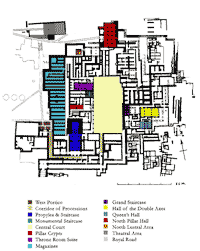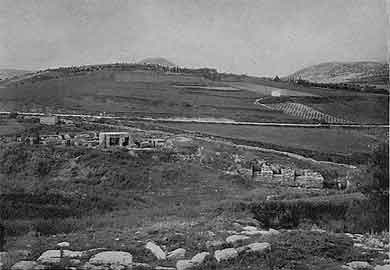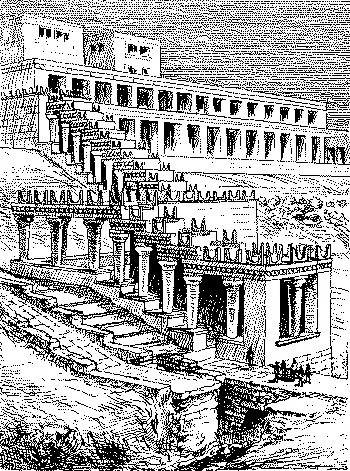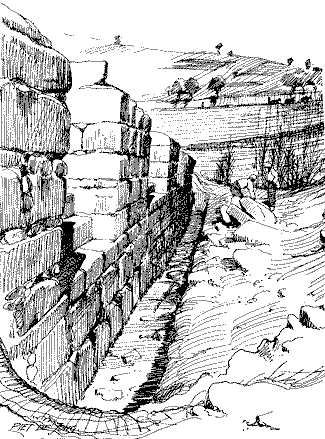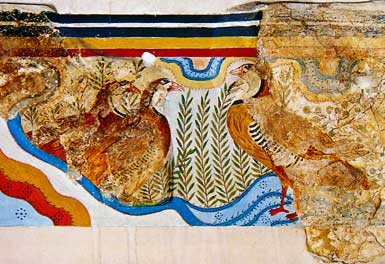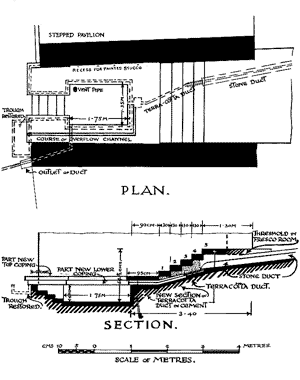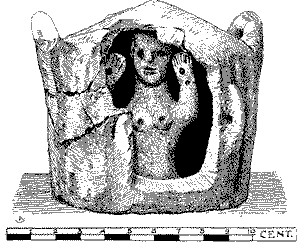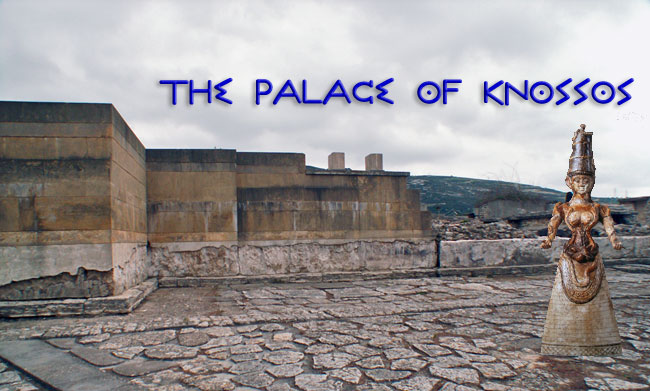
The Southern Approach
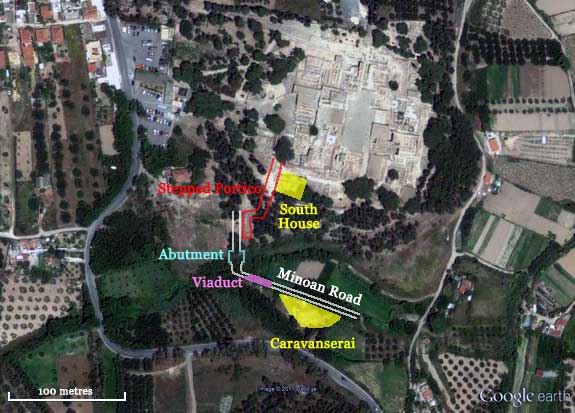
GoogleEarth View of Southern Approach
Evans believed that, during the First and Second Palace Period, the main approach to the Palace was from the south. In 1923, he uncovered a set of massive foundations for a Stepped 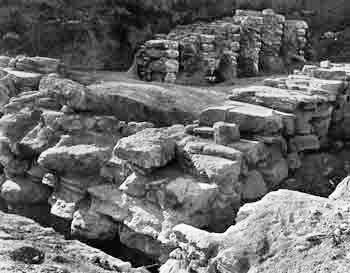 Portico that ran up the slope of the hill from what is now a deep gully through which flows a stream known as the Vlychià. Further investigation lead to the discovery of a massive stone viaduct that crossed the stream and traces of a Minoan road running away to the east.
Portico that ran up the slope of the hill from what is now a deep gully through which flows a stream known as the Vlychià. Further investigation lead to the discovery of a massive stone viaduct that crossed the stream and traces of a Minoan road running away to the east.
The Stepped Portico
The stepped portico was defined by two stone walls (right) about 2 metres thick line the sides of a what must have been a ramp 5 metres wide that headed from the north bank of the stream to the southwest corner of the palace. The eastern wall, where it survives, was made up of very solid looking masonry but its western companion consisted of a series of low walls made of rubble, enclosing a series of sturdy piers made out of carefully laid blocks set in a clay mortar. There were generally 6-8 slabs with the lowest one socketed into ‘cradles’ cut into the underlying limestone. These were evidently used to support the columns and create a structure that would both shade visitors to the palace and provide a suitably grand setting for ceremonial processions. According to Evans, it was built early in the First Palace 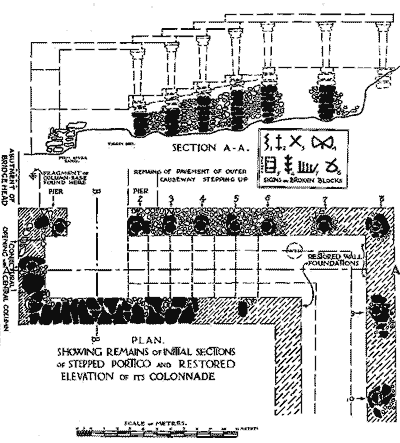 Period and stood until an earthquake struck it down at the end of the Second.
Period and stood until an earthquake struck it down at the end of the Second.
Evans was able to trace the walls up to a landing where it turned abruptly east and ran level for about 15 metres at which point all trace of it had been eradicated by later building activity. However, further up the slope, right by the southwest corner of the palace he was able to identify some paving slabs and a drain that were apparently contemporary with it, according to the ceramic evidence found with them. The paving slabs had been laid so that they slightly overlapped to create a stepped ramp and were oriented towards a point roughly 4 metres east of where the lower section had disappeared. Presumably the latter had been paved in a similar fashion originally but no trace has survived.
At the top of the ramp, the evidence is equally slim. Some fragments of ornamental stonework were found nearby leading Evans to reconstruct a hypothetical porch that would connect the portico with the South Corridor and thence to a set of stairs leading to the Corridor of Procession. It all seems quite reasonable but we will never know for certain.
The Minoan Viaduct
Having discovered what appeared to be a formal entrance to the palace from the south, Evans decided to see if he could discover a Minoan road leading up to it. So in 1924 he began to excavate on the opposite bank of the Vlychià, at a spot that roughly aligned with the start of the South Portico. After a lot of hard work, his workmen eventually recovered the 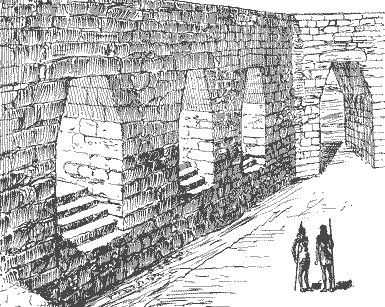 remains of a set of four massive piers used to support a viaduct.
remains of a set of four massive piers used to support a viaduct.
The piers were set on a base of roughly trimmed stone blocks ca. 5.50 metres across and at least 21.50 metres long. They ranged in width from 4.60 to 3.27 metres. The intervals between the piers were stepped and acted as culverts for the heavy runoffs that occurred from time to time. The width is suitable for a roadway and Evans proposed a series of corbelled vaults to support it. The whole structure would have been about 10 metres high, level with the top of the bank and the remains of the remains of a stone abutment on that opposite. The abutment is immediately west of the entrance to the Stepped Portico and about 7 metres downstream from the viaduct, so presumably the latter originally extended further and the stone was removed (along with any trace of the bridge) by later builders. Evans also found traces of pavement leading up the hill in the general direction of the West Court. Based on the pottery associated with its construction, Evans would date the structure to the beginning of the Second Palace Period.
The Caravanserai
Next to the presumed line of the Minoan road leading to the viaduct, Evans discovered the remains of a large building which he identified as a caravanserai, a type of inn for travelling merchants that was quite common in the Middle East until very recent times. These generally had compounds for stabling pack animals and facilities where the merchants could rest and refresh themselves. Evans found evidence for a painted pavilion, a shallow stone basin that he took to be a foot bath, large storerooms and rooms with cobbled floors suitable for the animals.
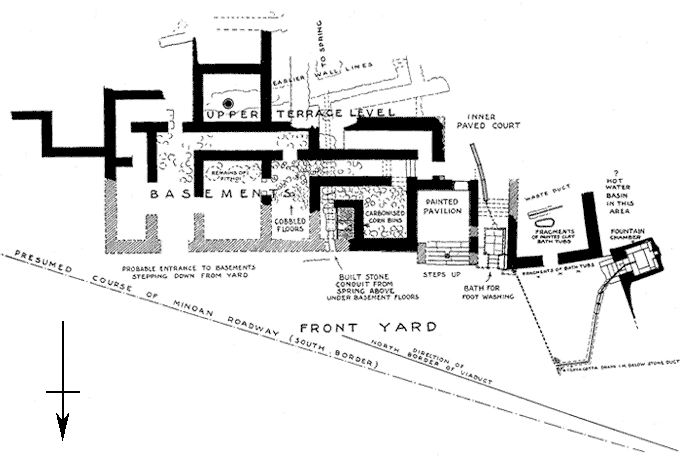
Plan of the Caravanserai
The building sits on the lower southern slope of the Gypsades Hill just below a somewhat brackish spring. Unfortunately, much of the façade has been obliterated (along with any trace of the road) by later activity and the upper terrace is badly denuded, so we do not know the full extent of the building. The complex is divided in two by a stone-lined covered conduit that carried water down from the spring and underneath the floors of the basement rooms. One of these produced carbonized wood and cereal grains (probably the remains of bins containing barley) while another contained broken storage jars (pithoi). As mentioned, some of the floors were cobbled, which Evans workmen agreed would have been excellent for stabling pack animals—it was good for the hooves, apparently. Presumably there was an entrance from the road but no trace of it has survived.
While the eastern part of the building appears to have been used mainly for storage, the rooms to the west served an entirely different function. In Evans opinion, they were designed for the well-being of those in charge of the transport of goods, call them “merchants” if you like.

Partridge Frieze as reconstructed by Evans and painted by Émile Guilliéron
Evans imagined the room that he called the Painted Pavilion as a shady area in which to relax and perhaps conduct a little business. It was approached by a portico with four steps and supported by a single column. A door at the rear led out to a paved courtyard beyond. The walls of the small room were decorated with painted stucco. Only the bottoms of the walls survive but the debris inside the room was full of plaster fragments.
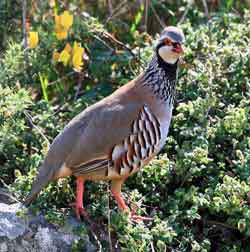 The surviving decoration consists of white panels framed by representations of “ochreous yellow” pillars 27 cm. wide, on red bases—three on each of the side walls and one on the back. In Evans’ reconstruction these supported an architrave 23 cm. wide, of a similar colour. Above that was a frieze of birds, 28 cm. broad, mainly partridges along with the occasional hoopoe, in a highly stylized landscape. Above the frieze and marking the transition from the walls to the ceiling were linear bands of red, yellow, black and white.
The surviving decoration consists of white panels framed by representations of “ochreous yellow” pillars 27 cm. wide, on red bases—three on each of the side walls and one on the back. In Evans’ reconstruction these supported an architrave 23 cm. wide, of a similar colour. Above that was a frieze of birds, 28 cm. broad, mainly partridges along with the occasional hoopoe, in a highly stylized landscape. Above the frieze and marking the transition from the walls to the ceiling were linear bands of red, yellow, black and white.
The best preserved sections are on the west wall and depict a bird that closely resembles the male Red-Legged Partridge (Alectoris rufa) of southern Europe (left). The rounded leaves of the bush in which the hoopoe sits, reminded Evans of dittany (Origanum dictamnus), which flourishes on the island and was well known for its medicinal (and magical) properties. The partridges, on the other hand, are found in clumps of what appears to be wild myrtle—another healing plant.
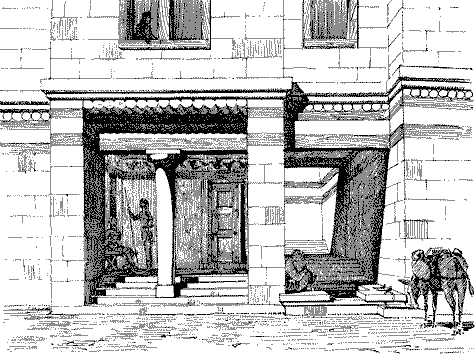
Reconstruction of part of the north façade of the Caravanserai showing the entrances to the Painted Portico and the Stone Bath (Evans, PM 2-1, fig. 55)
Immediately next to the portico was a smaller room known as the Stone Bath that was used for lustral activities. It was essentially a small, relatively narrow hall measuring 5.75 x 2.10 metres. A short flight of three steps led down from the front yard and into a shallow, stone-lined basin 1.52 by 1.38 metres and 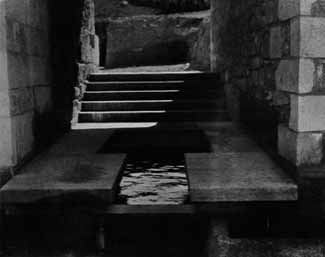 45 cm. deep—a suitable depth, Evans thought, to have served as a foot bath for dusty travellers. (right) It was surrounded by a number of flat slabs which overhung it by about 20 cm. and were presumably used as seats. At the rear of the chamber a flight of five broader steps led up to what appears to have been an inner courtyard.
45 cm. deep—a suitable depth, Evans thought, to have served as a foot bath for dusty travellers. (right) It was surrounded by a number of flat slabs which overhung it by about 20 cm. and were presumably used as seats. At the rear of the chamber a flight of five broader steps led up to what appears to have been an inner courtyard.
The bath was connected to an elaborate water system. The basin was fed by a stone conduit running from the general direction of the spring, that fed into a terracotta pipe. Some of the water flowed down a channel underneath one of the stone seats and flowed out into the yard. Evans thought it may have fed a trough for the pack animals (as in the illustration above). Another channel took the overflow through the western wall of the room and off towards the road. In addition, there was a drain in the bottom of the basin (although the stopper is missing).
The room next door was contained the broken pieces of at least two painted terracotta bathtubs. The room was fairly small (although the back end of it had been totally eradicated). There was some terracotta piping in the room but there is little to suggest that the finds are anything more than rubbish disposal.
A little to the west of the main block of the Caravanserai was a small, free-standing structure looking across the façade of the main building that Evans called the Spring Chamber and which almost certainly served as a shrine. A set of three steps led down from the front yard to a tiny chamber. On excavation it proved to be very similar to the Stone Bath, with a number of flat slabs 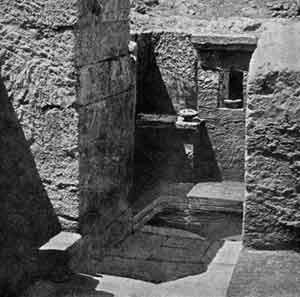 surrounding a rectangular basin except, in this case, it was fed by a spring that bubbled up through a pebble floor. The border slab nearest the doorway was well-worn by people getting water from the pool. Their was a socket stone for a doorpost, so access to the room was controlled to some extent. At the rear of the chamber there is a niche with a double cornice and a pair of pedestals of similar design that most likely served as altars. As is the case with the bath next door, surplus water was carried away in a terracotta pipe. In this case, it could be traced as far as the presumed line of the Minoan road.
surrounding a rectangular basin except, in this case, it was fed by a spring that bubbled up through a pebble floor. The border slab nearest the doorway was well-worn by people getting water from the pool. Their was a socket stone for a doorpost, so access to the room was controlled to some extent. At the rear of the chamber there is a niche with a double cornice and a pair of pedestals of similar design that most likely served as altars. As is the case with the bath next door, surplus water was carried away in a terracotta pipe. In this case, it could be traced as far as the presumed line of the Minoan road.
Just outside the entrance, Evans found a small pile of stone lamps and has restored a couple of them in the photograph (left). Most of the interior was “chock full” of offering vessels, clay bowls and incense burners, some of which contained the carbonized remains of their contents. At the bottom of the deposit, immediately above the floor of the basin, was a small terracotta model of a shrine containing the figure of a naked woman with her arms upraised. The contents of the fill was generally late in date, some of it dating to the Post-Palatial Period. By that time, the spring had been blocked by tectonic activity and ceased to function.
Unless otherwise stated, all black & white photos of Knossos are from The Palace of Minos by Arthur Evans and are reproduced here courtesy of the Ashmolean Museum, Oxford University

